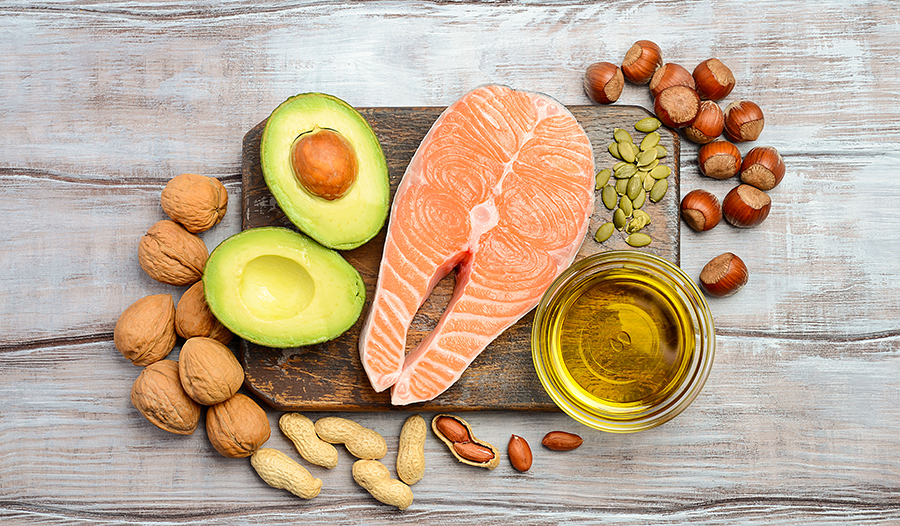How to Get More Omega-3 in Your Diet

When you think of omega-3s you might picture a giant platter of salmon or a handful of fish oil capsules. But what is this nutrient and why do you need it in your diet?
What Is Omega-3?
Omega-3 fatty acids are essential for human health and development and are constantly being studied for potential health benefits. They play an important role in brain function and inflammation and may reduce the risk of coronary heart disease.
There are three main types of omega-3s:
- Docosahexaenoic acid (DHA)
- Eicosapentaenoic acid (EPA)
- Alpha-linolenic acid (ALA)
The two most biologically active omega-3 fatty acids are DHA and EPA which are found in fatty fish like salmon and sardines. (Interestingly, these fatty acids are originally synthesized by microalgae, not the fish. When fish consume microalgae, they accumulate omega-3s in their tissues.)
ALA is the most common source of omega-3s in the American diet and is found in plant foods such as flaxseeds, chia seeds and walnuts. ALA is enzymatically converted to DHA or EPA in the body at a very low rate (<1%-15%) so it is important to consume a variety of omega-3 sources.
Is There a Recommended Intake for Omega-3?
The current dietary guidelines recommend that adults eat eight or more ounces of a variety of seafood (fish or shellfish) per week.
There isn’t a recommended daily allowance set for omega-3s in particular, but the current Adequate Intake level set by the National Institute of Health is 1.1g/day for females and 1.6g/day for males in the form of ALA. (Remember, ALA is the form of omega-3 found in plant foods.) If you look at the following list of ALA food sources, you can see this is quite easy to achieve.
- Flaxseed oil, 1 tablespoon: 7.26 grams
- Chia seeds, 1 ounce: 5.06 grams
- English walnuts, 1 ounce: 2.57 grams
- Flaxseed, whole, 1 tablespoon: 2.35 grams
What Are the Best Food Sources of DHA and EPA?
As I mentioned earlier, the omega-3s found in fish come from the food they eat and accumulate in their tissues. So fish that consume more microalgae and have more fatty tissue have higher levels of DHA and EPA. To get the most benefits from seafood, it’s a good idea to eat a wide variety. Here are some examples.
Grams per serving
DHA EPA
- Salmon, Atlantic, wild, cooked, 3 ounces 1.22 0.35
- Herring, Atlantic, cooked, 3 ounces 0.94 0.77
- Sardines, canned in tomato sauce, drained, 3 ounces 0.74 0.45
- Salmon, pink, canned, drained, 3 ounces 0.63 0.28
- Trout, rainbow, wild, cooked, 3 ounces 0.44 0.40
What Are the Benefits of Omega-3s?
According to the National Institute of Health, omega-3 supplements may help relieve symptoms of rheumatoid arthritis and slow the progression of age-related macular degeneration.
As far as cardiovascular health goes, there have been conflicting health claims on omega-3s over the years, but two new studies are clearing the way for more accurate recommendations.
- One large multiyear study published by The New England Journal of Medicine found a significant reduction in major cardiovascular events (19%), and heart attacks (40%) for people who consumed less than 1.5 servings of fish a week and added an omega-3 supplement (DHA + EPA) of 1 gram/day. They also saw a 77% reduction in heart attacks for African-American participants taking the same supplement. This study is currently examining the effect of these supplements on cognitive decline, diabetes, depression and autoimmune disorders and will publish those results sometime in 2020.
- Another study in The New England Journal of Medicine focused on high triglyceride levels in people who had risk factors for heart disease or had already experienced a cardiovascular event. This study used a prescription strength high-dose 4 gram/day supplement of EPA only and found a 25% reduction in the risk of dying from heart disease or suffering from a heart attack, stroke or chest pain (angina).
So what can we take away from this new research?
- If you eat less than 1.5 servings of fish per week, it’s a good idea to increase your fish intake or look into an omega-3 supplement.
- If you have African-American heritage, an omega-3 supplement may benefit you.
- If you have high triglycerides and risk factors for cardiovascular disease, you may want to talk with your doctor about taking a high-dose omega-3 product.
If you’re looking to increase your omega-3 intake and either have a hard time fitting seafood into your diet or don’t eat it at all, there are a variety of supplements you can take. Fish oil supplements are a rich source of DHA and EPA. If you are vegan or avoid fish for other reasons, there are vegan options, even for DHA and EPA (remember that microalgae I told you about that the fish eat?).
Talk with your doctor before adding an omega-3 supplement if you are on blood thinners, antiplatelet drugs, or anti-inflammatory medicine, or if you are pregnant, have a high risk of diabetes or high LDL cholesterol.
What Are Some Easy Ways to Add More Fish to My Diet?
For many Americans, eating more fish can seem intimidating or overwhelming, but there are lots of easy ways to enjoy seafood without becoming a professional chef. Here are a few of my favorite ways to include more seafood in my diet.
- Fish tacos: These are so quick and easy! Marinate a filet of cod or tilapia in a combination of lime juice, olive oil, cumin and cilantro for 15 minutes. Throw it in a pan over medium-high heat for around 3 minutes per side, or until the fish flakes easily. Serve with warmed corn tortillas and your favorite toppings!
- Sheet pan meals: Throw your favorite veggies onto a sheet pan with salmon or shrimp, olive oil, salt and pepper and roast at 425 degrees for 15 minutes. Choose a veggie that cooks quickly like asparagus or broccoli.
- Take advantage of canned options. From tuna to sardines, salmon to oysters, canned seafood is a great (and easy) way to add more fish into your diet. Try adding smoked mussels or oysters to your next snack plate of cheese and crackers or stash a bag of tuna in your bag for a quick and healthy lunch. Below is one of my favorite recipes using canned seafood.
Asian Salmon Salad Recipe
This is a recipe I’ve made over and over, and it’s great with canned tuna. But, and this is so cool, when you swap out the tuna and use canned salmon instead, you get almost 5 times as much omega-3s!
Ingredients:
- 2 cans salmon, drained
- 1/2 cup red cabbage, shredded
- 1 large carrot, shredded
- 1 clove garlic, minced
- 1 tsp. fresh ginger, peeled and minced
- 1 tsp. chili pepper flakes (optional, adjust for heat preference)
- 2 Tbs. olive oil
- 1 tsp. toasted sesame oil
- 3 Tbs. rice vinegar
- 1 tsp. sugar
- 2 Tbs. fresh cilantro, chopped
- 1 green onion, chopped
- Salt and pepper to taste
Instructions:
- Combine all ingredients in a large bowl.
- Stir and refrigerate.
- Serve in lettuce cups or on toasted bread.
Add a sprinkle of flaxseeds or walnuts for an ALA boost!
DISCLAIMER:This Wellness Hub does not intend to provide diagnosis...













































































 Table of Contents
Table of Contents
















